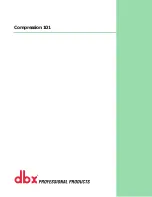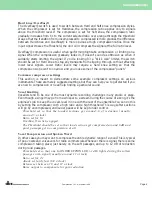
again after a loud signal has stopped; when it’s turned counter-clockwise, he pushes the fader
back up instantly, and when it’s full clockwise, he’ll take longer to push his fader back up to
unity gain.
The [OUTPUT] control is simply a gain control located after our “automatic engineer in the
box.”The [INPUT/OUTPUT] switch allows you to see the levels before the engineer does his
job, or after.
The most important controls are the [THRESHOLD] and [RATIO] knobs.They both interact
to get the effect you want, and that requires some experimenting. For example, if your
average input signal is 0 dB, a ratio of 2:1 with a threshold of -12 dB will give you 6 dB of
gain reduction, as will a ratio of infinity with a threshold of -6 dB. But the latter setting will
sound more “squeezed” than the former.
Avoid common compressor mistakes
Extreme settings will lead to extreme results. If you set an infinite ratio and turn the
threshold down to -40 dB, the compressor will do what it’s being told to do: turn the level
way down. If you then try to compensate by cranking the [OUTPUT] control to its
maximum, you’ll amplify the noise of your mixer, EQ, Mic preamp, and the compressor itself.
The noise will fade itself in whenever the input signal stops, resulting in the classic
“pumping” and “breathing” problems. Noise is present in every system, and improper use of
any compressor will amplify it to an obnoxious level.
If the ratio is set to 1:1, it doesn’t matter where the [THRESHOLD] control is: the compressor
is being told not to change the gain at all, even if it’s above the threshold level. None of the
REDUCTION LEDs will light, and you may as well have the compressor in BYPASS mode.
Similarly, if the ratio is infinite and the threshold is high, or the input trim of the mixer or
microphone preamp is too low, you will get no compression (and, if you raise the [OUTPUT]
level control, you’ll be amplifying the noise floor). For low noise operation, make sure your
mixer, compressor, and amplifier settings are set properly.As a general rule, you want as much
gain as possible in the front of the system (at the microphone preamp), so that a good line-
level signal is travelling through the whole signal path. if you have a weak signal to start with,
and then amplify it at the end of the signal path (by turning the main outputs of the mixer
all the way up, for example) it will be excessively noisy.
When using a compressor on a live P.A. system, improper settings can cause feedback. Make
sure that a channel is well below the feedback point when there is no gain reduction active.
If you hear feedback every time the music stops, you must lower the overall level of the
system.
About stereo compression
For great technical information on stereo processing, see the dbx white paper called True
RMS Power Summing®, written by Roger Johnson, Director of dbx Engineering.
Otherwise read on...
Compression 101 - November 1998
Page 2
¨
Compression 101
Summary of Contents for Compression 101
Page 1: ...Compression 101...


























